Microbes in human welfare
CHAPTER 10
MICROBES IN HUMAN WELFARE
Besides macroscopic plants and animals, microbes are the major components of biological systems on this earth. You have studied about the diversity of living organisms in Class XI. Do you remember which Kingdoms among the living organisms contain micro-organisms? Which are the ones that are only microscopic? Microbes are present everywhere - in soil, water, air, inside our bodies and that of other animals and plants. They are present even at sites where no other life-form could possibly exist - sites such as deep inside the geysers (thermal vents) where the temperature may be as high as 1000C, deep in the soil, under the layers of snow several metres thick, and in highly acidic environments. Microbes are diverse– protozoa, bacteria, fungi and microscopic animal and plant viruses, viroids and also prions that are proteinacious infectious agents. Some of the microbes are shown in Figures 10.1 and 10.2.
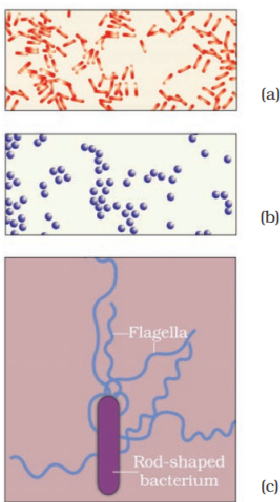
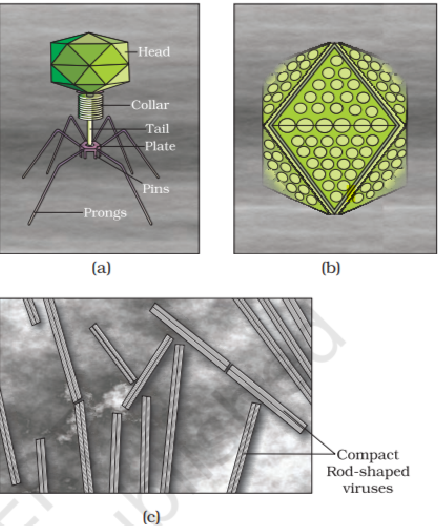
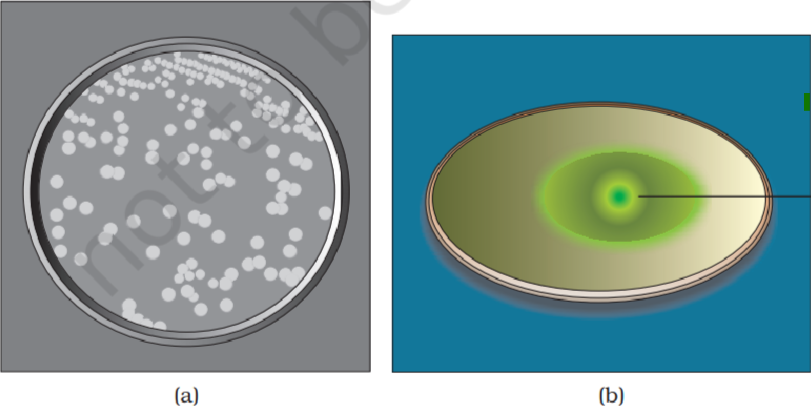
Microbes like bacteria and many fungi can be grown on nutritive media to form colonies (Figure 10.3), that can be seen with the naked eyes. Such cultures are useful in studies on micro-organisms.
In chapter 8, you have read that microbes cause a large number of diseases in human beings. They also cause diseases in animals and plants. But this should not make you think that all microbes are harmful; several microbes are useful to man in diverse ways. Some of the most important contributions of microbes to human welfare are discussed in this chapter.
10.1 MICROBES IN HOUSEHOLD PRODUCTS
You would be surprised to know that we use microbes or products derived from them everyday. A common example is the production of curd from milk. Micro-organisms such as Lactobacillus and others commonly called lactic acid bacteria (LAB) grow in milk and convert it to curd. During growth, the LAB produce acids that coagulate and partially digest the milk proteins. A small amount of curd added to the fresh milk as inoculum or starter contain millions of LAB, which at suitable temperatures multiply, thus converting milk to curd, which also improves its nutritional quality by increasing vitamin B12. In our stomach too, the LAB play very beneficial role in checking diseasecausing microbes.
The dough, which is used for making foods such as dosa and idli is also fermented by bacteria. The puffed-up appearance of dough is due to the production of CO2 gas. Can you tell which metabolic pathway is taking place resulting in the formation of CO2? Where do you think the bacteria for these fermentations come from? Similarly the dough, which is used for making bread, is fermented using baker’s yeast (Saccharomyces cerevisiae). A number of traditional drinks and foods are also made by fermentation by the microbes. ‘Toddy’, a traditional drink of some parts of southern India is made by fermenting sap from palms. Microbes are also used to ferment fish, soyabean and bambooshoots to make foods. Cheese, is one of the oldest food items in which microbes were used. Different varieties of cheese are known by their characteristic texture, flavour and taste, the specificity coming from the microbes used. For example, the large holes in ‘Swiss cheese’ are due to production of a large amount of CO 2 by a bacterium named Propionibacterium sharmanii. The ‘Roquefort cheese’ are ripened by growing a specific fungi on them, which gives them a particular flavour.
10.2 MICROBES IN INDUSTRIAL PRODUCTS
Even in industry, microbes are used to synthesise a number of products valuable to human beings. Beverages and antibiotics are some examples. Production on an industrial scale, requires growing microbes in very large vessels called fermentors (Figure 10.4).
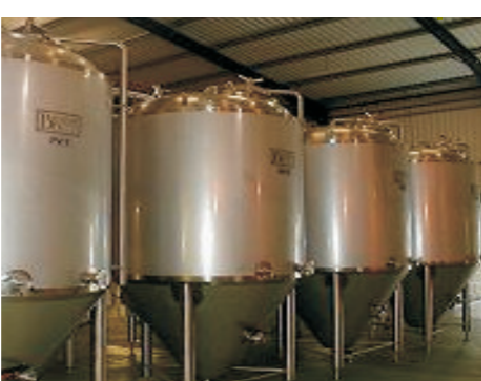
10.2.1 Fermented Beverages
Microbes especially yeasts have been used from time immemorial for the production of beverages like wine, beer, whisky, brandy or rum. For this purpose the same yeast Saccharomyces cerevisiae used for bread-making and commonly called brewer’s yeast, is used for fermenting malted cereals and fruit juices, to produce ethanol. Do you recollect the metabolic reactions, which result in the production of ethanol by yeast? Depending on the type of the raw material used for fermentation and the type of processing (with or without distillation) different types of alcoholic drinks are obtained. Wine and beer are produced without distillation whereas whisky, brandy and rum are produced by distillation of the fermented broth. The photograph of a fermentation plant is shown in Figure 10.5.

10.2.2 Antibiotics
Antibiotics produced by microbes are regarded as one of the most significant discoveries of the twentieth century and have greatly contributed towards the welfare of the human society. Anti is a Greek word that means ‘against’, and bio means Figure 10.5 Fermentation Plant ‘life’, together they mean ‘against life’ (in the context of disease causing organisms); whereas with reference to human beings, they are ‘pro life’ and not against. Antibiotics are chemical substances, which are produced by some microbes and can kill or retard the growth of other (disease-causing) microbes.
You are familiar with the commonly used antibiotic Penicillin. Do you know that Penicillin was the first antibiotic to be discovered, and it was a chance discovery? Alexander Fleming while working on Staphylococci bacteria, once observed a mould growing in one of his unwashed culture plates around which Staphylococci could not grow. He found out that it was due to a chemical produced by the mould and he named it Penicillin after the mould Penicillium notatum. However, its full potential as an effective antibiotic was established much later by Ernest Chain and Howard Florey. This antibiotic was extensively used to treat American soldiers wounded in World War II. Fleming, Chain and Florey were awarded the Nobel Prize in 1945, for this discovery.
After Penicillin, other antibiotics were also purified from other microbes. Can you name some other antibiotics and find out their sources? Antibiotics have greatly improved our capacity to treat deadly diseases such as plague, whooping cough (kali khansi ), diphtheria (gal ghotu) and leprosy (kusht rog), which used to kill millions all over the globe. Today, we cannot imagine a world without antibiotics.
10.2.3 Chemicals, Enzymes and other Bioactive Molecules
Microbes are also used for commercial and industrial production of certain chemicals like organic acids, alcohols and enzymes. Examples of acid producers are Aspergillus niger (a fungus) of citric acid, Acetobacter aceti (a bacterium) of acetic acid; Clostridium butylicum (a bacterium) of butyric acid and Lactobacillus (a bacterium) of lactic acid.
Yeast (Saccharomyces cerevisiae) is used for commercial production of ethanol. Microbes are also used for production of enzymes. Lipases are used in detergent formulations and are helpful in removing oily stains from the laundry. You must have noticed that bottled fruit juices bought from the market are clearer as compared to those made at home. This is because the bottled juices are clarified by the use of pectinases and proteases. Streptokinase produced by the bacterium Streptococcus and modified by genetic engineering is used as a ‘clot buster’ for removing clots from the blood vessels of patients who have undergone myocardial infarction leading to heart attack.
Another bioactive molecule, cyclosporin A, that is used as an immunosuppressive agent in organ-transplant patients, is produced by the fungus Trichoderma polysporum. Statins produced by the yeast Monascus purpureus have been commercialised as blood-cholesterol lowering agents. It acts by competitively inhibiting the enzyme responsible for synthesis of cholesterol.
10.3 MICROBES IN SEWAGE TREATMENT
We know that large quantities of waste water are generated everyday in cities and towns. A major component of this waste water is human excreta. This municipal waste-water is also called sewage. It contains large amounts of organic matter and microbes. Many of which are pathogenic. Have you ever wondered where this huge quantity of sewage or urban waste water is disposed off daily? This cannot be discharged into natural water bodies like rivers and streams directly - you can understand why. Before disposal, hence, sewage is treated in sewage treatment plants (STPs) to make it less polluting. Treatment of waste water is done by the heterotrophic microbes naturally present in the sewage. This treatment is carried out in two stages:
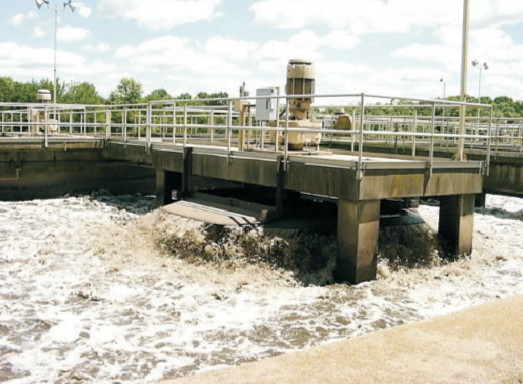
Primary treatment : These treatment steps basically involve physical removal of particles - large and small - from the sewage through filtration and sedimentation. These are removed in stages; initially, floating debris is removed by sequential filtration. Then the grit (soil and small pebbles) are removed by sedimentation. All solids that settle form the primary sludge, and the supernatant forms the effluent. The effluent from the primary settling tank is taken for secondary treatment. Secondary treatment or Biological treatment : The primary effluent is passed into large aeration tanks (Figure 10.6) where it is constantly agitated mechanically and air is pumped into it. This allows vigorous growth of useful aerobic microbes into flocs (masses of bacteria associated with fungal filaments to form mesh like structures). While growing, these microbes consume the major part of the organic matter in the effluent. This significantly reduces the BOD (biochemical oxygen demand) of the effluent. BOD refers to the amount of the oxygen that would be consumed if all the organic matter in one liter of water were oxidised by bacteria. The sewage water is treated till the BOD is reduced. The BOD test measures the rate of uptake of oxygen by micro-organisms in a sample of water and thus, indirectly, BOD is a measure of the organic matter present in the water. The greater the BOD of waste water, more is its polluting potential.
Once the BOD of sewage or waste water is reduced significantly, the effluent is then passed into a settling tank where the bacterial ‘flocs’ are allowed to sediment. This sediment is called activated sludge. A small part of the activated sludge is pumped back into the aeration tank to serve as the inoculum. The remaining major part of the sludge is pumped into large tanks called anaerobic sludge digesters. Here, other kinds of bacteria, which grow anaerobically, digest the bacteria and the fungi in the sludge. During this digestion, bacteria produce a mixture of gases such as methane, hydrogen sulphide and carbon dioxide. These gases form biogas and can be used as source of energy as it is inflammable.
The effluent from the secondary treatment plant is generally released into natural water bodies like rivers and streams. An aerial view of such a plant is shown in Figure 10.7.
You can appreciate how microbes play a major role in treating millions of gallons of waste water everyday across the globe. This methodology has been practiced for more than a century now, in almost all parts of the world. Till date, no manmade technology has been able to rival the microbial treatment of sewage.
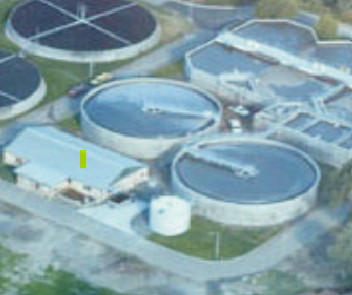
You are aware that due to increasing urbanisation, sewage is being produced in much larger quantities than ever before. However the number of sewage treatment plants has not increased enough to treat such large quantities. So the untreated sewage is often discharged directly into rivers leading to their pollution and increase in water-borne diseases.
The Ministry of Environment and Forests has initiated Ganga Action Plan and Yamuna Action Plan to save these major rivers of our country from pollution. Under these plans, it is proposed to build a large number of sewage treatment plants so that only treated sewage may be discharged in the rivers. A visit to a sewage treatment plant situated in any place near you would be a very interesting and educating experience.
10.4 MICROBES IN PRODUCTION OF BIOGAS
Biogas is a mixture of gases (containing predominantly methane) produced by the microbial activity and which may be used as fuel. You have learnt that microbes produce different types of gaseous end-products during growth and metabolism. The type of the gas produced depends upon the microbes and the organic substrates they utilise. In the examples cited in relation to fermentation of dough, cheese making and production of beverages, the main gas produced was CO2.. However, certain bacteria, which grow anaerobically on cellulosic material, produce large amount of methane along with CO2 and H2. These bacteria are collectively called methanogens, and one such common bacterium is Methanobacterium. These bacteria are commonly found in the anaerobic sludge during sewage treatment. These bacteria are also present in the rumen (a part of stomach) of cattle. A lot of cellulosic material present in the food of cattle is also present in the rumen. In rumen, these bacteria help in the breakdown of cellulose and play an important role in the nutrition of cattle. Do you think we, human beings, are able to digest the celluose present in our foods? Thus, the excreta (dung) of cattle, commonly called gobar, is rich in these bacteria. Dung can be used for generation of biogas, commonly called gobar gas.
The biogas plant consists of a concrete tank (10-15 feet deep) in which bio-wastes are collected and a slurry of dung is fed. A floating cover is placed over the slurry, which keeps on rising as the gas is produced in the tank due to the microbial activity. The biogas plant has an outlet, which is connected to a pipe to supply biogas to nearby houses. The spent slurry is removed through another outlet and may be used as fertiliser. Cattle dung is available in large quantities in rural areas where cattle are used for a variety of purposes. So biogas plants are more often built in rural areas. The biogas thus produced is used for cooking and lighting. The picture of a biogas plant is shown in Figure 10.8. The Figure 10.8 A typical biogas plant technology of biogas production was developed in India mainly due to the efforts of Indian Agricultural Research Institute (IARI) and Khadi and Village Industries Commission (KVIC). If your school is situated in a village or near a village, it would be very interesting to enquire if there are any biogas plants nearby. Visit the biogas plant and learn more about it from the people who are actually managing it.
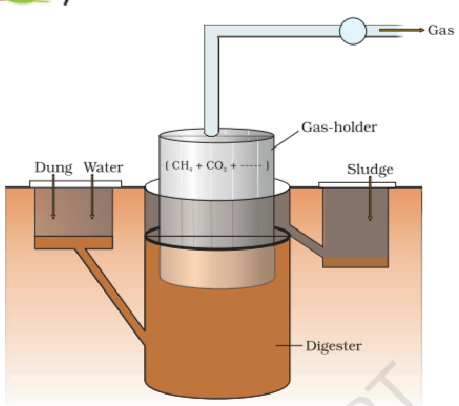
10.5 MICROBES AS BIOCONTROL AGENTS
Biocontrol refers to the use of biological methods for controlling plant diseases and pests. In modern society, these problems have been tackled increasingly by the use of chemicals - by use of insecticides and pesticides. These chemicals are toxic and extremely harmful, to human beings and animals alike, and have been polluting our environment (soil, ground water), fruits, vegetables and crop plants. Our soil is also polluted through our use of weedicides to remove weeds.
Biological control of pests and diseases: In agriculture, there is a method of controlling pests that relies on natural predation rather than introduced chemicals. A key belief of the organic farmer is that biodiversity furthers health. The more variety a landscape has, the more sustainable it is. The organic farmer, therefore, works to create a system where the insects that are sometimes called pests are not eradicated, but instead are kept at manageable levels by a complex system of checks and balances within a living and vibrant ecosystem. Contrary to the ‘conventional’ farming practices which often use chemical methods to kill both useful and harmful life forms indiscriminately, this is a holistic approach that seeks to develop an understanding of the webs of interaction between the myriad of organisms that constitute the field fauna and flora. The organic farmer holds the view that the eradication of the creatures that are often described as pests is not only possible, but also undesirable, for without them the beneficial predatory and parasitic insects which depend upon them as food or hosts would not be able to survive. Thus, the use of biocontrol measures will greatly reduce our dependence on toxic chemicals and pesticides. An important part of the biological farming approach is to become familiar with the various life forms that inhabit the field, predators as well as pests, and also their life cycles, patterns of feeding and the habitats that they prefer. This will help develop appropriate means of biocontrol.
The very familiar beetle with red and black markings - the Ladybird, and Dragonflies are useful to get rid of aphids and mosquitoes, respectively. An example of microbial biocontrol agents that can be introduced in order to control butterfly caterpillars is the bacteria Bacillus thuringiensis (often written as Bt ). These are available in sachets as dried spores which are mixed with water and sprayed onto vulnerable plants such as brassicas and fruit trees, where these are eaten by the insect larvae. In the gut of the larvae, the toxin is released and the larvae get killed. The bacterial disease will kill the caterpillars, but leave other insects unharmed. Because of the development of methods of genetic engineering in the last decade or so, the scientists have introduced B. thuringiensis toxin genes into plants. Such plants are resistant to attack by insect pests. Bt-cotton is one such example, which is being cultivated in some states of our country. You will learn more about this in chapter 12.
A biological control being developed for use in the treatment of plant disease is the fungus Trichoderma. Trichoderma species are free-living fungi that are very common in the root ecosystems. They are effective biocontrol agents of several plant pathogens.
Baculoviruses are pathogens that attack insects and other arthropods. The majority of baculoviruses used as biological control agents are in the genus Nucleopolyhedrovirus. These viruses are excellent candidates for species-specific, narrow spectrum insecticidal applications. They have been shown to have no negative impacts on plants, mammals, birds, fish or even on non-target insects. This is especially desirable when beneficial insects are being conserved to aid in an overall integrated pest management (IPM) programme, or when an ecologically sensitive area is being treated.
10.6 MICROBES AS BIOFERTILISERS
With our present day life styles environmental pollution is a major cause of concern. The use of the chemical fertilisers to meet the ever-increasing demand of agricultural produce has contributed significantly to this pollution. Of course, we have now realised that there are problems associated with the overuse of chemical fertilisers and there is a large pressure to switch to organic farming - the use of biofertilisers. Biofertilisers are organisms that enrich the nutrient quality of the soil. The main sources of biofertilisers are bacteria, fungi and cyanobacteria. You have studied about the nodules on the roots of leguminous plants formed by the symbiotic association of Rhizobium. These bacteria fix atmospheric nitrogen into organic forms, which is used by the plant as nutrient. Other bacteria can fix atmospheric nitrogen while free-living in the soil (examples Azospirillum and Azotobacter), thus enriching the nitrogen content of the soil.
Fungi are also known to form symbiotic associations with plants (mycorrhiza). Many members of the genus Glomus form mycorrhiza. The fungal symbiont in these associations absorbs phosphorus from soil and passes it to the plant. Plants having such associations show other benefits also, such as resistance to root-borne pathogens, tolerance to salinity and drought, and an overall increase in plant growth and development. Can you tell what advantage the fungus derives from this association?
Cyanobacteria are autotrophic microbes widely distributed in aquatic and terrestrial environments many of which can fix atmospheric nitrogen, e.g. Anabaena, Nostoc, Oscillatoria, etc. In paddy fields, cyanobacteria serve as an important biofertiliser. Blue green algae also add organic matter to the soil and increase its fertility. Currently, in our country, a number of biofertilisers are available commercially in the market and farmers use these regularly in their fields to replenish soil nutrients and to reduce dependence on chemical fertilisers.
SUMMARY
Microbes are a very important component of life on earth. Not all microbes are pathogenic. Many microbes are very useful to human beings. We use microbes and microbially derived products almost every day. Bacteria called lactic acid bacteria (LAB) grow in milk to convert it into curd. The dough, which is used to make bread, is fermented by yeast called Saccharomyces cerevisiae. Certain dishes such as idli and dosa, are made from dough fermented by microbes. Bacteria and fungi are used to impart particular texture, taste and flavor to cheese. Microbes are used to produce industrial products like lactic acid, acetic acid and alcohol, which are used in a variety of processes in the industry. Antibiotics like penicillins produced by useful microbes are used to kill disease-causing harmful microbes. Antibiotics have played a major role in controlling infectious diseases like diphtheria, whooping cough and pneumonia. For more than a hundred years, microbes are being used to treat sewage (waste water) by the process of activated sludge formation and this helps in recycling of water in nature. Methanogens produce methane (biogas) while degrading plant waste. Biogas produced by microbes is used as a source of energy in rural areas. Microbes can also be used to kill harmful pests, a process called as biocontrol. The biocontrol measures help us to avoid heavy use of toxic pesticides for controlling pests. There is a need these days to push for use of biofertilisers in place of chemical fertilisers. It is clear from the diverse uses human beings have put microbes to that they play an important role in the welfare of human society.
EXERCISES
1. Bacteria cannot be seen with the naked eyes, but these can be seen with the help of a microscope. If you have to carry a sample from your home to your biology laboratory to demonstrate the presence of microbes with the help of a microscope, which sample would you carry and why?
Answer
Curd can be used as a sample for the study of microbes. Curd contains numerous lactic acid bacteria (LAB) orLactobacillus. These bacteria produce acids that coagulate and digest milk proteins. A small drop of curd contains millions of bacteria, which can be easily observed under a microscope.
2. Give examples to prove that microbes release gases during metabolism.
Answer
The examples of bacteria that release gases during metabolism are:
(a) Bacteria and fungi carry out the process of fermentation and during this process, they release carbon dioxide. Fermentation is the process of converting a complex organic substance into a simpler substance with the action of bacteria or yeast. Fermentation of sugar produces alcohol with the release of carbon dioxide and very little energy.
$$ \text { Glucose } \xrightarrow[\text { oxygen }]{\text { without }} \text { alcohol }+ \text { energy }+\mathrm{CO}_{2} $$
(b) The dough used for making idli and dosa gives a puffed appearance. This is because of the action of bacteria which releases carbon dioxide. This $\mathrm{CO}_{2}$ released from the dough gets trapped in the dough, thereby giving it a puffed appearance.
3. In which food would you find lactic acid bacteria? Mention some of their useful applications.
Answer
Lactic acid bacteria can be found in curd. It is this bacterium that promotes the formation of milk into curd. The bacterium multiplies and increases its number, which converts the milk into curd. They also increase the content of vitamin $\mathrm{B}_{12}$ in curd.
4. Name some traditional Indian foods made of wheat, rice and Bengal gram (or their products) which involve use of microbes.
Answer
(a) Wheat:
Product: Bread, cake, etc.
2. Rice:
Product: Idli, dosa
2. Bengal gram:
Product: Dhokla, Khandvi
5. In which way have microbes played a major role in controlling diseases caused by harmful bacteria?
Several micro-organisms are used for preparing medicines. Antibiotics are medicines produced by certain microorganisms to kill other disease-causing micro-organisms. These medicines are commonly obtained from bacteria and fungi. They either kill or stop the growth of disease-causing micro-organisms. Streptomycin, tetracycline, and penicillin are common antibiotics. Penicillium notatum produces chemical penicillin, which checks the growth of staphylococci bacteria in the body. Antibiotics are designed to destroy bacteria by weakening their cell walls. As a result of this weakening, certain immune cells such as the white blood cells enter the bacterial cell and cause cell lysis. Cell lysis is the process of destroying cells such as blood cells and bacteria.
6. Name any two species of fungus, which are used in the production of the antibiotics.
Answer
Antibiotics are medicines that are produced by certain micro-organisms to kill other disease-causing microorganisms. These medicines are commonly obtained from bacteria and fungi.
The species of fungus used in the production of antibiotics are:
| Antibiotic | Fungus source |
|---|
| 1. | Penicillin | Penicillium notatum |
|---|---|---|
| 2. | Cephalosporin | Cephalosporium acremonium |
7. What is sewage? In which way can sewage be harmful to us?
Answer
Sewage is the municipal waste matter that is carried away in sewers and drains. It includes both liquid and solid wastes, rich in organic matter and microbes. Many of these microbes are pathogenic and can cause several waterborne diseases. Sewage water is a major cause of polluting drinking water. Hence, it is essential that sewage water is properly collected, treated, and disposed.
8. What is the key difference between primary and secondary sewage treatment?
Answer
| Primary sewage treatment | Secondary sewage treatment | |
|---|---|---|
| 1. | It is a mechanical process involving the removal of coarse solid materials. |
1. It is a biological process involving the action of microbes. |
| 2. | It is inexpensive and relatively less complicated. | 2. It is a very expensive and complicated process. |
9. Do you think microbes can also be used as source of energy? If yes, how?
Answer
Yes, microbes can be used as a source of energy. Bacteria such as Methane bacterium is used for the generation of gobargas or biogas.
The generation of biogas is an anaerobic process in a biogas plant, which consists of a concrete tank (10-15 feet deep) with sufficient outlets and inlets. The dung is mixed with water to form the slurry and thrown into the tank. The digester of the tank is filled with numerous anaerobic methane-producing bacteria, which produce biogas from the slurry. Biogas can be removed through the pipe which is then used as a source of energy, while the spent slurry is removed from the outlet and is used as a fertilizer.
10. Microbes can be used to decrease the use of chemical fertilisers and pesticides. Explain how this can be accomplished.
Answer
Microbes play an important role in organic farming, which is done without the use of chemical fertilizers and pesticides. Bio-fertilizers are living organisms which help increase the fertility of soil. It involves the selection of beneficial micro-organisms that help in improving plant growth through the supply of plant nutrients. Bio-fertilizers are introduced in seeds, roots, or soil to mobilize the availability of nutrients. Thus, they are extremely beneficial in enriching the soil with organic nutrients. Many species of bacteria and cyanobacteria have the ability to fix free atmospheric nitrogen.Rhizobium is a symbiotic bacteria found in the root nodules of leguminous plants. Azospirillium and Azotobocter are free living nitrogen-fixing bacteria, whereas Anabena, Nostoc and Oscillitoria are examples of nitrogen-fixing cyanobacteria. Bio-fertilizers are cost effective and ecofriendly.
Microbes can also act as bio-pesticides to control insect pests in plants. An example of bio-pesticides is Bacillus thuringiensis, which produces a toxin that kills the insect pests. Dried bacterial spores are mixed in water and sprayed in agricultural fields. When larvae of insects feed on crops, these bacterial spores enter the gut of the larvae and release toxins, thereby it. Similarly, Trichoderma are free living fungi. They live in the roots of higher plants and protect them from various pathogens.
Baculoviruses is another bio-pesticide that is used as a biological control agent against insects and other arthropods.
11. Three water samples namely river water, untreated sewage water and secondary effluent discharged from a sewage treatment plant were subjected to BOD test. The samples were labelled A, B and C; but the laboratory attendant did not note which was which. The BOD values of the three samples A, B and C were recorded as 20mg/L, 8mg/L and 400mg/L, respectively. Which sample of the water is most polluted? Can you assign the correct label to each assuming the river water is relatively clean?
Answer
Biological oxygen demand (BOD) is the method of determining the amount of oxygen required by micro-organisms to decompose the waste present in the water supply. If the quantity of organic wastes in the water supply is high, then the number of decomposing bacteria present in the water will also be high. As a result, the BOD value will increase.
Therefore, it can be concluded that if the water supply is more polluted, then it will have a higher BOD value. Out of the above three samples, sample $\mathbf{C}$ is the most polluted since it has the maximum BOD value of $400 \mathrm{mg} / \mathrm{L}$. After untreated sewage water, secondary effluent discharge from a sewage treatment plant is most polluted. Thus, sample $\mathbf{A}$ is secondary effluent discharge from a sewage treatment plant and has the BOD value of $20 \mathrm{mg} / \mathrm{L}$, while sample $\mathbf{B}$ is river water and has the BOD value of $8 \mathrm{mg} / \mathrm{L}$.
Hence, the correct label for each sample is:
| Label | BOD value | Sample |
|---|---|---|
| A. | $20 \mathrm{mg} / \mathrm{L}$ | Secondary effluent discharge from a sewage treatment plant |
| B. | $8 \mathrm{mg} / \mathrm{L}$ | River water |
|---|---|---|
| C. | $400 \mathrm{mg} / \mathrm{L}$ | Untreated sewage water |
12. Find out the name of the microbes from which Cyclosporin A (an immunosuppressive drug) and Statins (blood cholesterol lowering agents) are obtained.
Answer
| Drug | Function | Microbe | |
|---|---|---|---|
| 1. | Cyclosporine - A | Immuno suppressive drug | Trichoderma polysporum |
| 2. | Statin | Blood cholesterol lowering agent | Monascus purpureus |
13. Find out the role of microbes in the following and discuss it with your teacher. (a) Single cell protein (SCP) (b) Soil
Answer
(a) Single cell protein (SCP)
A single cell protein is a protein obtained from certain microbes, which forms an alternate source of proteins in animal feeds. The microbes involved in the preparation of single cell proteins are algae, yeast, or bacteria. These microbes are grown on an industrial scale to obtain the desired protein. For example, Spirulina can be grown on waste materials obtained from molasses, sewage, and animal manures. It serves as a rich supplement of dietary nutrients such as proteins, carbohydrate, fats, minerals, and vitamins. Similarly, micro-organisms such as Methylophilus and methylotrophushave a large rate of biomass production. Their growth can produce a large amount of proteins.
(b) Soil
Microbes play an important role in maintaining soil fertility. They help in the formation of nutrient-rich humus by the process of decomposition. Many species of bacteria and cyanobacteria have the ability to fix atmospheric nitrogen into usable form. Rhizobium is a symbiotic bacteria found in the root nodules of leguminous plants. Azospirillium andAzotobocter are free living nitrogen-fixing bacteria, whereas Anabena, Nostoc, and Oscillitoria are examples of nitrogen-fixing cyanobacteria.
14. Arrange the following in the decreasing order (most important first) of their importance, for the welfare of human society. Give reasons for your answer. Biogas, Citric acid, Penicillin and Curd?
Answer
The order of arrangement of products according to their decreasing importance is:
Penicillin- Biogas - Citric acid - Curd
Penicillin is the most important product for the welfare of human society. It is an antibiotic, which is used for controlling various bacterial diseases. The second most important product is biogas. It is an eco-friendly source of energy. The next important product is citric acid, which is used as a food preservative. The least important product is curd, a food item obtained by the action of lactobacillus bacteria on milk
Hence, the products in the decreasing order of their importance are as follows:
Penicillin- Biogas - Citric acid - Curd
15. How do biofertilisers enrich the fertility of the soil?
Answer
Bio-fertilizers are living organisms which help in increasing the fertility of soil. It involves the selection of beneficial micro-organisms that help in improving plant growth through the supply of plant nutrients. These are introduced to seeds, roots, or soil to mobilize the availability of nutrients by their biological activity. Thus, they are extremely beneficial in enriching the soil with organic nutrients. Many species of bacteria and cyanobacteria have the ability to fix free atmospheric nitrogen.Rhizobium is a symbiotic bacteria found in the root nodules of leguminous plants. Azospirillium and Azotobocter are free living nitrogen-fixing bacteria, whereas Anabena, Nostoc, and Oscillitoria are examples of nitrogen-fixing cyanobacteria. Bio-fertilizers are cost effective and ecofriendly.






